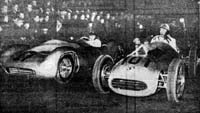Phoenix from the flames, part 7: EMW
Author
Date
- September 4, 2002
Related articles
- Early post-war German F2, F Libre and sports cars - Phoenix from the flames, by 'Uechtel'
- Introduction
- Part 1: Veritas
- Part 2: AFM
- Part 3: The smaller marques
- Part 4: West German BMW specials
- Part 5: Foreign appearances and guest drives
- Part 6: East German BMW specials
- AFM - Alex von Falkenhausen's brave F2 effort, by Mattijs Diepraam
- Early post-war German F2 cars - The BMW-derived specials that appeared in war-struck Germany, by Mattijs Diepraam
- Veritas - Self-made German privateers to the fore, by Mattijs Diepraam
Why?
There could hardly have been a stranger place for two race cars to appear in a January night in 1954 than the Stalinallee in the GDR's capital, East Berlin! But this picture is a good expression for the position motorsport had to occupy in the public life of this socialist state and how it had to serve for political propaganda in the fifties.
"Living proof for the precision labour of our working people"
Factory race cars from Eisenach
In January 1954 cold war had reached nearly boiling temperature. While both sides had just come to an unsafe armistice after nearly four years of war, far away in the most remote angle of Vietnam the besiege of the French at Dien Bien Phu had already begun. In this stressed atmosphere Berlin became the stage of one of the last of the great political post-war conferences between the former allies. The foreign ministers of the four victory powers, John Foster Dulles of the USA, Anthony Eden from Great Britain, George Bidault from France and Vatcheslav M. Molotov of the Soviet Union met alternating in the Western and in the Eastern Sectors of the city to gamble about the future of the two Germanies.
When the negotiations finally failed this meant the end of the Soviets' plan of a reunited and neutralized German state between the blocks, to which both halfs became integrational parts, thus cementing the divison of the country for a long time.
But what is the connection to motor racing?
Motorsport has always fascinated the masses, thus being an ideal platform for a country's industry to demonstrate its technical superiority. Of course this was no different within the GDR, where the introduction of socialism meant that state, society, politics and economy were regarded as a unity. The whole industry had been nationalized and was run according to a centralized "plan". And because of the loss of the West German and international supply industry all had to be produced at home: cars from Eisenach and Zwickau, tyres from Riesa, IKA ignition systems, ISOLATOR spark-plugs, ABUS gearboxes, spoke wheels from Ronneburg, special oils and lubricants from Lützkendorf and so on. So successes of East German cars on the race tracks were promoting all of these products and proof to the world of the superiority of the socialist system, with a very important side-effect being the population's increased confidence in the future of the young state.
So the great political events of the time were a welcome platform to demonstrate the country's motorsport heroes' support of state ideology, with the whole world – or at least the whole country – looking on. The results were theatrical scenes like those on the picture, with Edgar Barth and Arthur Rosenhammer driving their EMW race cars along the East Berlin Stalinallee up to the building of the National Council of the GDR to wish them all the best for the success of the conference in the name of the workers at the Eisenach factory.
Of course the use of propaganda was not limited to East Germany only. An increasing number of racing drivers were expecting - and not wholly unjustified - to find better opportunities in the West and joined the stream of emigrants by committing the crime of Republikflucht (defecting from the GDR). This was exploited with great delight by the Western press and politicians, who in return did not hesitate to exhibit the former idols of socialism as living proof for the political and economical suppression system within the GDR. Therefore it must have taken a lot of pressure off the East German leaders when they finally were able to present a prominent political refugee of their own in person of pre-war Mercedes star driver Manfred von Brauchitsch, who escaped to the GDR after being politically prosecuted in the West.
Indeed the East German motorsport press, which was always more of a platform for propaganda paroles and official political statements, with serious race reports playing a secondary role, was full of proclamations for "freedom for Manfred von Brauchitsch"; in the name of the "free working people" and "world peace", wasting no opportunity to emphasize the advantages of life in the GDR. The following extract from Illustrierter Motorsport, the official organ of the GDR's motorsport section, is shown here as a good example for this - comparing crowded spectator tribunes at that year's Sachsenring race to a scarcely filled grandstand at the Nürburgring, claimed to be photographed during the 1000km race earlier that year - as a proof that the proletariate in the West did not have the standard of living to afford the entry fee in their daily battle for survival.
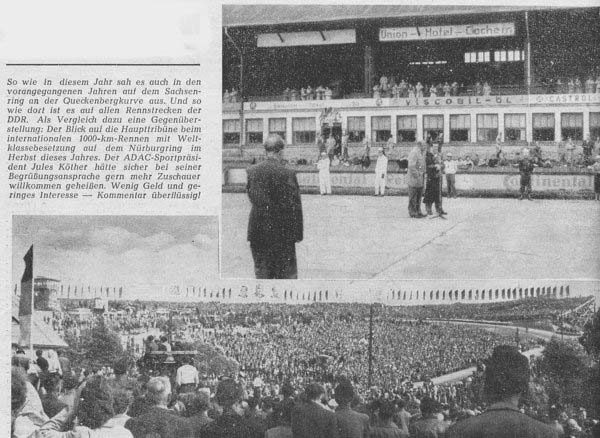
Pictures like these give a good impression of how difficult it is today to extract the tiny pieces of truth out of the flood of propaganda when working with contemporary East German sources. Politically unwanted persons, unsuccessful projects and developments, which did not finally achieve what had been aimed for, were not useful for demonstrating the superiority of socialism and tended to disappear from history, like Alexander Dubcek, General Secretary of the Czechoslovakian Communist Party, does on this famous 1968 picture, taken after the Prague Spring. It does not happen often that the researching historian has the luck to find that there is at least a shoe left…
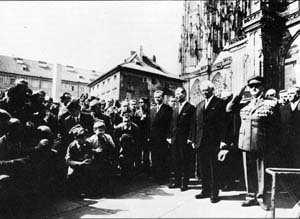

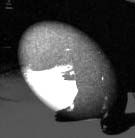
With Dubcek (left), without Dubcek (right), and the shoe that gave the clue (bottom).
Automobilwerk Eisenach (Awtowelo-BMW)
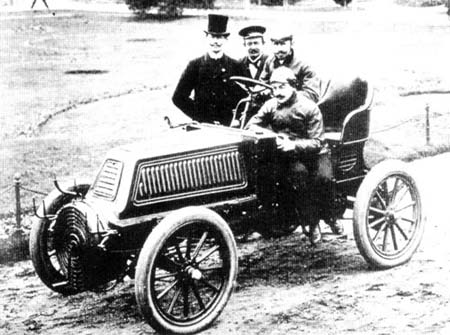
First of a long tradition of race cars from Eisenach: The Wartburg 80hp, built for the 1902 Paris-to-Vienna race.
Pre-History (1896-1945)
The Fahrzeugfabrik Eisenach has a long tradition in automobile production, which reaches back well into the 19th century. Heinrich Ehrhardt, who was running one of the most important industrial empires in Germany, comparable to names like Krupp or Siemens, already had armament factories in the Rheinland and Westfalia. In 1896 he founded the plant at Eisenach, where among other military goods he produced gun-carriages and bicycles under the Wartburg brand.
In 1899 he decided to get into car production as well, initially producing light cars on a French Decauville license. As early as 1902 the first types of a race car were manufactured, two of which took part in Paris-Vienna. But only Franz Kirchheim's car lasted the distance, finishing in 53rd position, 27th in the light car class.
The dispersion of activities at Eisenach resulted in a loss of profit and Ehrhardt lost control of the factory. But he did not give up and founded a new automobile company under his own name in the neighbourhood, at Zella-Mehlis and St. Blasii.
At Eisenach the marque's name was changed into Dixi in 1903 and car and lorry production was held up during WW I. After the war Germany was struck by a series of economical crises, which brought the factory under control of the notorious stock-jobber Jacob Schapiro, who already had influence on other car companies, like NSU, Cyclon, Schebera and Hansa, and was also responsible for the fusion of Daimler and Benz.
With a production line of expensive high-quality cars the Dixi factory soon ran into financial trouble. The solution was to produce a small and cheap car, but the development progress was too slow. In spite of that a big loan had already been raised to finance the mass production and the only possible way out of this dilemma was to buy the license of the successful Austin Seven.
In 1929 Schapiro's activities finally led to the deeply indebted Dixi factory being sold to the BMW company, which had concentrated on engines and motorcycles so far. Under the BMW banner the Austin was followed by the models of the very successful 3xx series in the thirties, all produced at Eisenach, climaxing in the famous BMW 328. This great sports car, which was covered earlier in this series of articles, became the origin of a whole flood of sports and racing descendants in and outside Germany before and after WW II.

The BMW/EMW 340, the first post-war design from the Eisenach factory
Years of Reformation (1945-1955)
At the end of WW II the former BMW factory at Eisenach, in spite of its location in the Russian zone, had the luck of being initially occupied by American troops. Thus it escaped from the first big wave of destruction - in contrast to the former Auto Union plants in Saxony.
When finally the Soviets took over control the former BMW factory at Eisenach was expropriated and converted into the so-called SAG (Soviet Shareholder Company) Awtowelo, which continued the production of the successful pre-war 321 and 326 models as early as in October 1945. This meant, that the Volkswagenwerk at Wolfsburg and the Eisenach factory were the first German automobile works that took up production after the war while it lasted until 1952 before the first cars left the assembly lines of the parent BMW plant at Munich.
In 1948 the production of the BMW 340 started, the first German car of post-war design, of course still based on the line of the approved six-cylinder models. At the same time the pre-war 327 sports car, which was a more civilized version of the 2-litre six-cylinder than the 328, was produced again.
At that time the Eisenach factory prospered from its SAG format, which was kept until 1952 and secured some advantages in the supply of materials compared to the IFA. This abbreviation for Industrieverwaltung Fahrzeugbau (Industrial Administration of Vehicle Production) was the synonym for a conglomerate of 17 automobile and 8 coachwork plants in conjunction with 22 repair shops all over Saxony, which had been amalgamated together in 1947, including what had remained of the former Auto Union factories. These had been completely dismantled immediately after the war and the machinery was transferred to the Soviet Union as a form of reparation payment together with all (18) of the surviving Auto Union Grand Prix cars. In 1948 the IFA concern was extended to the whole of the Eastern Zone and restarted production of two-stroke DKW models in 1949.
In 1952 the two BMW companies at Munich and Eisenach fought a legal dispute over the rights of the BMW name. The Eastern side lost, which resulted in a half-hearted change of the marque's name from BMW into EMW (Eisenacher Motoren Werke) and the introduction of a red and white emblem which beared great resemblance to the original blue and white BMW logo.
In the same year the factory finally returned to full German control, which meant that it lost its independence completely, as it was incorporated into the IFA immediately. In the centralized East German economy the FEW (Forschungs- und Entwicklungswerk - Institute for Research and Development), Auto Union's former R&D department at Chemnitz, became responsible for all new GDR car designs, thus also including the model policy at Eisenach.
Due to its structural errors and planning mistakes the economy of the GDR began to fall behind that of West Germany. This culminated in the riots on 17 June 1953, putting pressure on the GDR government to improve the supply of consumer goods, and as a symbol of prosperity, cars in particular.
To increase output the variety of models had to be decreased. The first victims of this policy would naturally be the complicated and expensive six-cylinder models from Eisenach. Their production line was replaced by that of the two-stroke DKW/IFA models, which had been completely transferred to Eisenach in order to free capacity at Zwickau for the East German Volkswagen, the Trabant.
This unification in the East German car industry was confirmed by yet another name-change of the Eisenach factory in 1955, now firming as the VEB (Volkseigener Betrieb - people's owned factory) Automobilwerk Eisenach, AWE in short, while the production in the former Auto Union works at Zwickau was run under the AWZ banner.
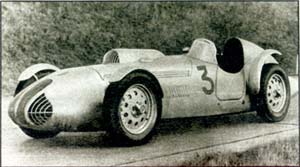
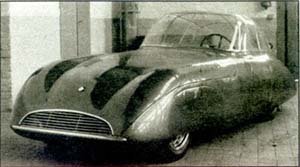
The first competition prototypes of the Eisenach factory after the war: the Intertyp (left) and the S1 Stromlinienwagen sports car (right). Both took part in the first races in the GDR at Dessau and at the Sachsenring in 1949.
The pioneer phase (1948-'49)
During the first post-war years it must have been very disappointing for the racing enthusiasts in the Soviet Occupation Zone to see motorsport blossoming again in West Germany while they themselves, who were equally able to look back on a great tradition of race and sports cars from the former Auto Union and BMW works, had to stay away initially. So it is no wonder that racing started all over again there, too, as soon as the GDR state had been founded in 1949.
The first race is only poorly documented in my archive, but it's a fact that it took place at Dessau, probably late in August or in the first half of September 1949. It is also known that the former BMW factory at Eisenach, still under Awtowelo ownership, was present with two entries under the banner of the Eisenacher Betriebssportgemeinschaft. According to state ideology such institutions were introduced at East German factories in order to organize the sporting activities of their workers, so sometimes it is difficult to decide whether this can be regarded as a works team in the true sense of the word or not, but of course the team received a certain amount of works support at least.
A 1986 issue of Illustrierter Motorsport gives the two cars shown on the pictures above as the two entries from Eisenach, both based on the successful BMW 328. The first model was named to be an Intertyp, an offset-seated dual-purpose sports/race car like so many others in that era. The other car, the S1, looks rather like the prototype of a road-going sports car than a true racing machine, fully streamlined with a fully enclosed cockpit canopy (which must have delivered quite a high amount of drag). One also misses the characteristical air-intake above the engine for the downdraught carburettors, which was so common for all the other BMW-based specials. So I am not yet quite convinced whether this was really the shape of the car that was entered at Dessau.
In fact it is doubtful whether the S1 took part in that race at all, as the sources begin already to diverge here. Interestingly, the 1953 Motorsport Almanach, edited by Günther Grassmann and Arthur Rosenhammer himself, credits victory to Kurt Baum and his Special in the race car class and to the S1 (without naming the driver) in the sports cars, while the aforementioned issue of Illustrierter Motorsport says that the S1 debuted only at the next race at the Sachsenring!
At least this next event is covered much better in contemporary reports. There seem to have been the usual classes and both cars from Eisenach were entered in the 2-litre sports car category. The Intertyp, driven by Rosenhammer, finished third behind two West Germans, Toni Ulmen and Theo Helfrich, both of course driving Veritas RS sports cars, while there is uncertainty again about Adolf Brudes in the streamliner being fourth in front of the BMW Specials of Greifzu and Niedermayr.
After that race the traces of the two cars begin to fade. For no known reason there seem to have been no racing activities of the Eisenach factory in 1950 altogether. This left the East German racing scene completely open for a West German invasion that year with Ulmen and Rieß totally dominating the prestigious race at the Sachsenring. But on the other hand the Intertyp seems to have been not simply put aside, but to have been the starting point for the development of the cars of the Rennkollektiv for 1951.
One question remains open still. Already in 1948 Adolf Brudes appeared at the Nürburgring race in a car that the entry list simply called a "BMW". As he seems to have been the Eisenach works driver for a while, this opens some room for speculation, namely that this car could have been an early development from Eisenach, too.
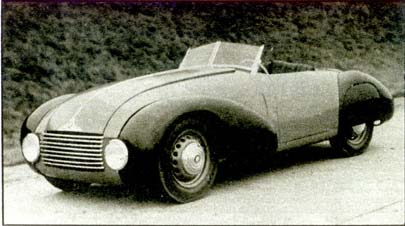
The BMW (later EMW) 340/I, the first East German sports car of post-war design.
Still covered by the dust of history – the EMW 340/1 (1948-1952)
After serial production of the "BMW" 340 started the Eisenach factory had enough capacity not only to build the two competition prototypes described above, but also to develop yet another sports version. The result was a nice roadster in modern style, the 340/I model (also called 340-1 or even 340 S).
Symptomatic for the contradiction in sources, Brudes is reported to have won the Formula 2 class at the Sachsenring in 1949 in a "BMW 340"! Surely this must have been a very competitive derivative instead of a standard limousine. So perhaps a 340/I? As it is also stated that this model had in fact some race appearances in the early fifties...
Confirmed is the fact that a certain Werner Jäger campaigned the 1952 season with a car that appeared as EMW 340/I in the entry list at the Sachsenring. In that year he seems to have been a regular contender in the sports car class, which was run in conjunction with the Formula 2 class on some occasions. So this could be a possible explanation why Jäger and his car appear in the results lists of this category.
Of course some action pictures of the 340/I (or its derivatives) would be very helpful to eliminate the remaining doubts…
Rennkollektiv Johannisthal (DAMW/IFA-Rennkollektiv)
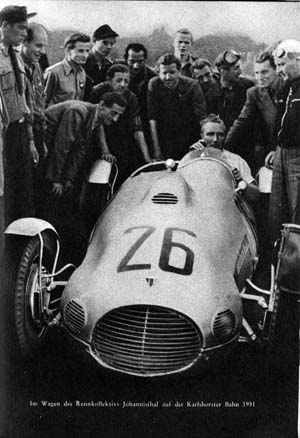
Is this man "Dr. Ring"? The picture shows pre-war ace Manfred von Brauchitsch at the volant of one of the newly founded Rennkollektiv Johannisthal's DAMW cars at the Berlin-Karlshorst dirt-track circuit in 1951.
The foundation of the Rennkollektiv and an Intra-German tragedy (1950-'51)
Probably in order to get control over their racing activities (remember, the SAG Awtowelo still belonged to the Soviets) the East German state initiated the foundation of an official race team in 1950. From January 1951 onward this found residence in a former repair shop of the Soviet Military Administration (SMAD) on the area of Berlin-Johannisthal airfield.
Labour in the GDR was strictly organized in sub-unities of Brigaden and Kollektive and consequently the new team was called Rennkollektiv ("racing collective") Johannisthal. The whole thing was subordinated to the Deutsches Amt für Material- und Warenprüfung (German Board for the Examination of Goods and Materials), DAMW in short, which was responsible for the direction of industrial production and material supply in the GDR.
The foundation of the team fell into a phase of bright optimism among the East German authorities. Now that the struggle of the early post-war years had been overcome and after the introduction of the new economic theories the success of their socialist experiment over the obsolete system of capitalism in the West seemed inevitable. And what better playground to demonstrate their expected technology advantage than an official motorsport engagement with full state backing? It would be only a matter of time before race cars from the GDR would become unbeatable…
In a representative collection of quotes in official GDR language the expected triumph was described like this:
"On initiative of the Deutscher Sportausschuß (German Committee of Sport) and with support by the sport-friendly government of the GDR a research work was commissioned by the Zentralamt für Forschung und Technik (Central Board for Research and Technology) to design and build sports and race cars and to take part and test them in automobile competitions in order to get useful results for the design of high-performance vehicles by the volkseigene ("people's owned") motor car industry… The intention is that - in contrast to the capitalist countries - the whole society shall benefit from the experience and knowledge won in the races, and not just a handful of privately owned concerns."
"The execution of this order was taken over by the DAMW (Deutsches Amt für Waren- und Materialprüfung) at its Versuchs- und Prüfamt für Kraftfahrzeugtechnik (Institute for Testing and Examination of Motor Vehicles) at Berlin-Johannisthal, a factory stuffed with the most modern of machine tools, where the best conditions for quick accomplishment of this labour can be found."
"The short-dated deadline did not allow a completely new development. Therefore approved aggregates of Eisenach production were used to create three types of racing cars, sports cars with 1.5 and 2-litre engines and Formula 2 cars, which comply to the international standards of automobile sports… Only in collective cooperation with the designers and the technological intelligence of the whole people's owned industry and without any rivalry between them it was possible to achieve all these tasks in the shortest period of time and in full accordance with the plan. Motorsport only makes sense when today's race car is tomorrow's daily driver."
"The results of the efforts at Johannisthal will be contributions that will help our production cars to become more efficient and cheaper in perspective, so that they will be available for an increasing part of the population. Under the condition that a racing vehicle has to be a testing laboratory of developments for the production series new parts were created with the intention to make the GDR independent of West German and foreign monopolies."
"In contrast to West Germany, where profit is still of the highest priority, there is a truly sporting spirit within the Rennkollektiv. Its only task is to bring our automobile industry to the highest possible standard of development and to bring up a team of highly talented experts, who drive for their native land and whose cars are a living proof of the quality and precision labour of the working people in our factories. The people's owned racing departments are by no means regarded as institutions merely intended for representation, which reduce success simply to a means of advertising…"
But besides this official story there is another version about the origins of this team, which contains an allusion to one of the great unsolved mysteries of motor racing, at least of its German history:
The initiative [for the Rennkollektiv] came from the outside: Race driver Dr. Ring had emigrated from West to East Germany at the end of the fourties and asked the president of the state, Wilhelm Pieck, to be allowed to help the motorsport activities of the country on its feet.
This is a very interesting remark, as the contemporary West German motorsport magazine Das Auto somewhat jealously stated "that neither his name was Ring, nor was he a true doctor, and that he ended up in prison for other reasons…"
So who was this obscure "Dr. Ring"? Certainly not the man really in charge of the team as suggested by the quote above. If so he should either have appeared as the team's manager or as one of its leading drivers. But these roles were clearly occupied by other persons, like Arthur Rosenhammer, who had already been involved in the race car project at Eisenach in 1949 before becoming technical director of the Rennkollektiv, while the general direction of the team was taken over by a certain Karl Trübsbach. No mention of Dr. Ring in my sources after 1951!
A very interesting theory about this issue comes from Michael Müller: could this "Dr. Ring" in fact be a pseudo identity of pre-war Mercedes ace Manfred von Brauchitsch? A strong argument in favour of this possibility is the fact that he is indeed the only well-known racing driver who chose to go the other way by fleeing from the West to the East. This move was of course caused by his prosecution in the West, where he was accused of high treason because of his presidence of the Westdeutsches Kommittee für Einigkeit und Freiheit im Deutschen Sport (West German Committee for Unity and Freedom in the German Sport), which was regarded as a subversive organization controlled by the Soviets. Remember, cold war was just about to enter its hottest phase and the prosecution of people who were suspected of sympathizing with communism was not an uncommon thing at the time, not just in Germany but in most countries in the western hemisphere. Finally these developments climaxed into the situation that von Brauchitsch requested political asylum in the GDR in January 1954!
According to Michael Müller's theory von Brauchitsch, who generally couldn't be regarded as one with much interest in politics, seems to have slid between the front lines. After the crack in his relationship to Neubauer in Belgrade in 1939 he certainly had no hope to continue as a member of the Mercedes team after the war. In fact it seems he had difficulties to get a drive at all, with the exception of a few starts on the AFM in 1950, while his former opponents, Stuck, Lang, Caracciola, Pietsch or H.P. Müller, were either able to more or less successfully continue their careers or at least sure that they would be phoned as soon as the Mercedes works team would be reactivated again.
So the jobless von Brauchitsch might have been well aware of the gap which was left open in East Germany after the closing-down of the former Auto Union team. And none of the pre-war top drivers was available there! As Michael Müller states:
"And blue-blooded sunny boy Manfred von Brauchitsch? The family wealth lost in the East, failure as business man, no profession to earn his living, prohibited from international racing, and neglected by his former employer Mercedes-Benz…
…For him [the move to the GDR] simply presented the chance to return to racing, if not as driver, then as an organizer. To contact Wilhelm Pieck, and to ask for permission to bring back motor racing to the circuits of East Germany, could have been typical von Brauchitsch behaviour in his somewhat silly kind of arrogance.
Interesting in this connection is the question about his activities in the AvD. Possibly he was a honorary member of the board or something similar, which gave him neither income nor influence, but would have given him the possibility to negotiate with East German authorities about the future of motorsport in the Eastern Zone. Obviously his idea to become GDR's racing driver No.1, or the head of a state-owned racing team, failed, as only as late as 1957 he was appointed president of the ADMV, the GDR's motorsport association. Most probably the GDR regime recognized that with von Brauchitsch they had something useful in hands, a publicly well-known sporting personality, embittered, and without clear personal convictions and targets - the ideal propaganda symbol to stop the continuous exodus of East Germans to the West."
Of course this theory is still full of assumptions which still need to be confirmed. But it sounds thrilling! Certainly an interesting case for future investigation.
Summing up it seems that von Brauchitsch was simply used by the East German authorities, that never really had the intention to give him some influence on the proceedings, and the same can probably be said about his involvements in the Rennkollektiv – if there were any at all. The story of this man is really an intra-German tragedy.
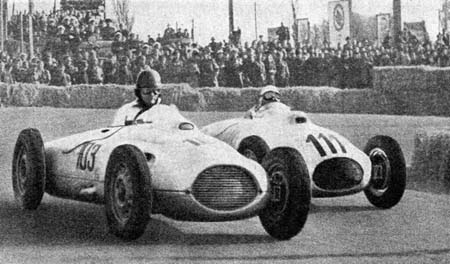
Krause (103, Reif-BMW) and Rosenhammer (111, DAMW) fighting for the lead, Leipzig 1951.
Onto the race tracks (1951, pt.I)
Taking into account the short period between January 1951, when the premises at Johannisthal were occupied, and April, when the first race took place at Halle, the EMW achievements were quite respectable indeed. At least three cars had been built, two in 2-litre form with another one for the 1.5-litre class. The latter was created by the usual reduction of the engine stroke from 96 to 73mm in conjunction with the use of roller bearings for the crankshaft, while the rest of the car seemed to be very much identical to the 2-litre models.
Further basic characteristics retained from the BMW 328 and common for all three versions were a standard tube section frame with a live rear axle and a swing axle at the front, consisting of a transversal leaf spring, which was simultaneously used as the upper part of the front suspension. All this was covered by the usual Intertyp bodywork with the option to detach the lights and the motorcycle-like wings. The whole car weighed about 600kg and delivered a power output of 125hp at 5500rpm in 2-litre configuration and 105hp at 6500rpm with the 1.5-litre engine.
Leading driver of the team was Arthur Rosenhammer. Born in Dessau in 1910 he had started his career as a sports car driver in 1938-'39 with a 1.5-litre BMW. In 1947 he was the first post-war driver from East Germany to take part in a race in West Germany, finishing second in the 1.5-litre sports car class in his BMW at the Schottenring.
In 1948 he appeared with his home-built ARO special in the Kleinstrennwagen category, in which he won the race at the Grenzlandring and scored some other good finishes at Dessau, Cologne, the Sachsenring and on the Nürburgring in 1948 and 1949.
In 1950 he started the obscure ARO-Veritas project, which is already covered in the East German Specials section, before he became head of the Rennkollektiv in 1951.
The sources seem to indicate that he was (or perhaps is?) a very ambitious person. This was not only expressed by the high positions that he achieved in the GDR's motorsport hierarchy, but also by the uncompromising driving style he regularily showed on the race track. In spite of the permanent assertions of sporting comradeship and fairness within the team, there is evidence on many occasions that an athmosphere of roughness and rivalry reigned among the drivers of the Kollektiv.
At Halle Paul Greifzu had been invited to drive the team's second car in the Formula 2 race, as his own special was not race-ready after the crash at the Nürburgring in 1950. This was of course a welcome occasion for him to check out the opposition, but due to the short development time the Kollektivwagen still suffered from their teething problems. So Greifzu and Rosenhammer had to retire early in the race, while Kurt Baum, chosen to drive the 1.5-litre car, at least achieved an impressive debut victory for the team in his class.
The picture gives a clear impression of how close the battle for the lead had been between Rosenhammer and Rudi Krause in the next race at Leipzig. But then the brakes of the Reif-BMW failed, resulting in a spectacular crash, and the way was open for the maiden Formula 2 victory of a Rennkollektiv car.
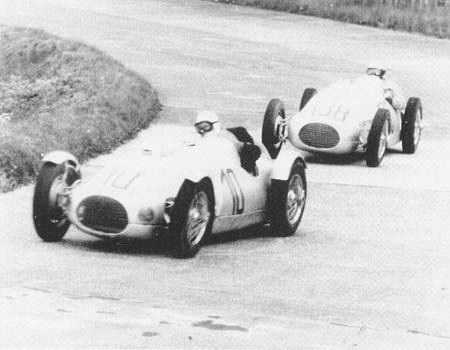
Team effort: The two Kollektivwagen of Theo Fitzau (10, in 2-litre sports car configuration) and Arthur Rosenhammer (138, Formula 2 entry) during practice for the Eifelrennen in 1951.
The challenge (1951, pt.II)
Of course "demonstrating the quality and precision of our working people" by "driving for our native land in true sporting spirit" meant "go to the West and blow them off". But what seems to be an obvious self-conceit from today's point of view appears to be less ridiculous when regarded in the context of the period. Before the war the people in Germany, not only those living around Chemnitz, Zwickau and other parts of Saxony, had become very accustomed to German superiority at the race tracks. The failure of marques like Veritas and AFM, not to speak of the many special builders, to re-establish this superiority in the early post-war years was initially very disappointing, but could at least be explained as being mere amateur efforts which were lacking the necessary technical and financial background in the aftermaths of war. So hopes still rested on big manufacturers like Mercedes, who would be ready to return to motor racing after the consolidation of German industry and would without any doubt regain their leading role among manufacturers like Maserati, Ferrari and Gordini, which in comparison to them were still regarded to be little more than dabblers themselves.
With the promises of socialism in mind the leaders of the GDR were already slowly losing contact to existing reality, as they seemed to firmly believe that the Rennkollektiv would soon be able to fill the void and continue the successful racing tradition of the former Auto Union and BMW factories. This might be also the reason why racing activities in East Germany tended to disperse just a little too much initially, for it seems that at the same time when the Rennkollektiv started its attack on the West German race tracks, yet another prestigious project had begun: the development of an Auto Union look-a-like rear-engined Formula 2 car. (For further circumstances surrounding this project please refer to Appendix A – The rear-engined mystery: Auto Union E-Type, DAMW, Sokol & Co.)
But nevertheless most of the West German public was at least impressed, too. The race of the two systems had begun and in spite of the difficulties that were already evident in the East German economy, it was by no means clear at that time which of them would gain final victory. So the appearance of the Rennkollektiv caused quite a stir when they turned up with no less than four entries altogether for the first of the big races of 1951 at the Nürburgring.
It is doubtful whether the entry of Kurt Baum in the 1.5-litre car actually materialized, as this would have meant that four cars existed at that time. But the appearing 2-litre machines were certainly enough to attract attention, especially after Rosenhammer managed to qualify for the front row of the grid in the 2-litre sports car race. But the impressive show in practice could not yet be transposed into countable results on race day as neither Rosenhammer nor the team's second driver Theo Fitzau appear in the results. This was reserved to Rosenhammer for the final Formula 2 race, in which he was able to take an initial lead right after the start. But before the end of the first lap he had been passed by Pietsch, finishing the race in seventh position. The first round had ended in favour of Veritas and West Germany.
After this result the Rennkollektiv was probably happy to have a brief intermezzo at Dresden in the absence of too much opposition from the West before the battle of the systems was to be continued. Only Klenk and Heeks had made the journey to the East, so Rosenhammer and newcomer Josef Ortschitt were clear favourites for the race.
But yet again it wasn't to be. The race, described in the East German Specials section (see also the picture there) has become one of the best remembered in GDR racing history, when the drivers of the Rennkollektiv – over-ambitious as ever – managed to eliminate each other in one of the first corners, while the impressive Paul Greifzu, who had been involved in that incident too, clearly stole the show when he fought his way back again into first position at the end.
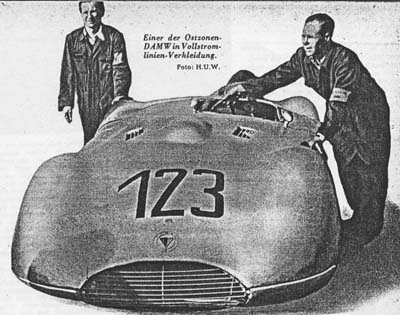
Rosenhammer's Avus streamliner.
The race of the systems (1951, pt.III)
At Avus the East-West battle entered its second stage. The importance of this prestigious race was underlined by a huge entry list containing nearly all of the German top drivers. Quite a number of streamlined derivatives had been developed especially for this high-speed track.
Rudi Fischer from Switzerland had brought his V12 Ferrari, Stirling Moss and Lance Macklin represented Great Britain in the HWM team, and there were three neat little Gordinis, which would of course suffer a little on this fast circuit due to their engine lacking 500cc in capacity.
Also the Rennkollektiv had developed a streamlined version of the car, which was given to Rosenhammer, while Fitzau and Ortschitt had to be content with standard models. Again the team was faced with much reservations by the Western press. Das Auto wrote:
"The DAMW engines are excellently prepared, sustain some 6,000 rpm without any complaint and make a full, healthy sound, which has not been cheap to get. Father Pieck [the president of the GDR] has spent around one million Marks on this enterprise, and it gets much more support from the GDR state besides that, too. And this million is now beginning to pay off."
But in the end it was not a driver employed by the East German state nor one of the other favourites from abroad but the unforgotten East German privateer Paul Greifzu who achieved an even more surprising victory than at Dresden, while the performance of the DAMWs was again disappointing. Rosenhammer's car failed after only five laps, so he took over that of Ortschitt, and he and Fitzau crossed the finish line four laps down to the winner in 7th and 11th places.
The result of the race was a shock to the West German public, that had felt safe from the East German threat after the Eifelrennen, and this perhaps is the explanation for the panic and the superficiality with which no difference was made between Greifzu's private effort and the DAMW enterprise. Again this is expressed by the reaction in Das Auto:
"Probably we will have to wait until East German race cars dominate our championship runs with all the resulting - and of course also intended - propagandistic effects, before the respective West German organs will begin to consider subsidies for race designs. The Küchen engine and the Meteor have probably proved to be equivalent to the latest productions or possibly even superior to them at least for a short while. The amount of money that is required for their proper development is of a dimension which is certainly small for a public budget but no longer affordable for the sporting enthusiasm of the few privateers."
But slowly in the GDR some disappointment began to take up some room as well, especially after the DAMW cars did not succeed at the Grenzlandring either and – most embarrassing – not at their home race at the Sachsenring where the Kollektivwagen were beaten by Greifzu once again!
With his successes in the 1951 season the East German privateer became the East German Formula 2 champion for the second time in a row while the Rennkollektiv had to be content with the less important titles in the 1500cc (Kurt Baum) and 2000cc (Kurt Straubel) sports car categories.
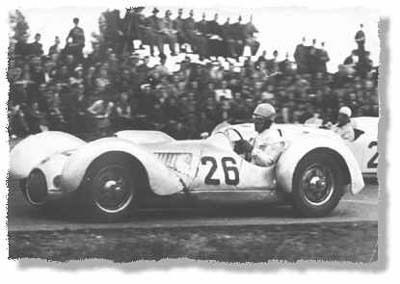
Kurt Straubel in the 1500cc DAMW just about to overtake Rolf Kühn's BMW in the Eifelrennen in 1952.
Into the second season (1952, Pt.I)
After an annoying first season in Formula 2 the IFA-Rennkollektiv VEB, as the team was now named officially, began to shift its priorities towards the 1500cc sports car class in 1952. With the Veritas RS gradually becoming more and more outdated the competition level in this category had not been too high in 1951, so that Walter Glöckler in a Porsche-engined Eigenbau had been able to win the West German title. And with the factory efforts of Porsche and Borgward not yet on the horizon perhaps the Rennkollektiv tried to find bigger chances for success in that category.
As a consequence the team regularly brought two 1.5-litre cars to the race tracks to be driven by Rosenhammer and Kurt Straubel, the latter replacing Baum in the team. Straubel was also chosen for the 2-litre category while Edgar Barth, the rising East German star, was now promoted to the team's No.1 Formula 2 drive. The second car in this class was handed to Jürgen Perduß as Theo Fitzau had recently deserted to the West.
On the technical side there seems to have been little change, as the cars appeared very similar to their original specification. Only the cycle-like wings were no longer allowed in sports car racing and had to be replaced by a type firmly attached to the bodywork like on the picture above.
The season started at Rostock, where in the Formula 2 race Greifzu was again unbeatable while the Kollektivfahrer Perduß and Barth were beaten into 3rd and 4th place by West German guest driver Josef Peters in his old-fashioned Veritas RS. The big sports car class was won by Theo Helfrich in another Veritas RS, while Straubel had a collision with a back-marker after a good battle for the lead in the early stages.
In the absence of Barth it was Krause's turn to win the Formula 2 category at Bernau from the lowly talented Perduß, while at least the 1500cc race was an easy march-through for the two DAMWs of Rosenhammer and Straubel. In the absence of any serious opposition in the East German championship their domination of this class was never really challenged throughout the 1952 season, with Rosenhammer finally winning the "national" title from his team-mate as a very predictable result.
The next event on the calendar was the sad race weekend at Dessau, where Greifzu suffered his fatal crash. Both DAMW cars ran into problems again and so it was a race for the West Germans, Rieß winning from Helfrich with Krause following in 3rd place as best of the locals.
After the East German curtain raisers it was time for the first act in this year's East-West drama, the Eifelrennen at the Nürburgring. In accordance with their new priorities the Rennkollektiv left out Formula 2 and the big sports car category completely to concentrate fully on the 1500cc class, where they had to face the brand-new factory Borgward driven by Hans Hugo Hartmann.
But it was a privateer again, Helm Glöckler in his Ramelow-Porsche, who crossed the line in first place with Rosenhammer and Straubel finishing in 4th and 5th position. But at least the DAMWs had been able to keep up the pace, showing a promising performance.
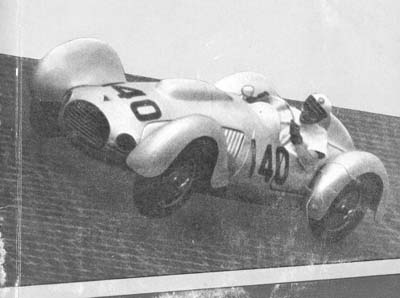
One of the fast 1.5 litre Kollektivwagen, probably in 1952 spec, at the banked Avus Nordkurve. Who can help to identify this picture? The bright helmet probably points towards Edgar Barth…
Finally a win (1952, pt.II)
In 1952 a "national" race at the Avus was introduced to the calendar, only open to German entrants. Obviously this still included East Germans, even if they were not admitted to score points in the West German championship (which was the reason why the GDR had introduced their own series in 1950).
The race contained neither runs for Formula 2 nor for 2-litre sports cars, so the 1.5-litre category would receive full attention from the crowd. Nine cars appeared for the start, among them the two DAMWs of Rosenhammer and Straubel and Nürburgring winner Glöckler in his Porsche Special.
These three also formed the leading group in the race before Straubel had to retire with an engine failure. In the end Rosenhammer won with an 8.2 second advantage from Glöckler with Kurt Baum, the "re-privateered" former Kollektivfahrer, in 3rd in his BMW Special.
This was the victory the Rennkollektiv had longed for so much and of course the East German press could not resist to extensively refer to this triumph over and over again. The fact that this was just a national race with no other factory entries present was of course not overly emphasized.
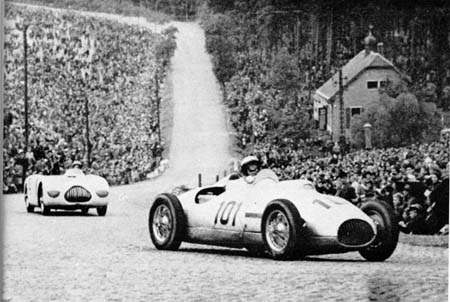
Edgar Barth in action, probably at the Sachsenring, leading from Helfrich's Veritas. Note the missing cover above the passenger's seat revealing the fuel tank, which had been installed there in order to achieve a neutral weight distribution without being effected by consumption.
In victory lane (1952, pt.III)
After the death of Paul Greifzu the East German Formula 2 championship was wide open for the man who would become the GDR's most famous driver, Edgar Barth. Born in 1917 as the son of a stocking manufacturer from the Erzgebirge, Barth began his motorsport activities in 1933, taking part in motorcycle trials. He was finally taken up in the DKW factory team in 1937. After the war he continued his career with class wins on a 350cc Norton at Halle, Leipzig and Erfurt. In 1951 the Rennkollektiv spotted his talent and enrolled him for some occasional appearances in Formula 2. He performed well enough to become the team's leading driver at the beginning of next season, but in spite of that he still found enough time to take part in motorcycle races.
With the race at Leipzig Barth began an impressive series of victories in the East German Formula 2 events, followed by wins at Halle and at the Sachsenring, only interrupted by his retirement in the second (non-championship) race at Leipzig, which was won by Stuck. Together with his fourth place at Rostock he had collected 21 points, which gave him an overwhelming lead in the final standings of the championship over Klodwig, who had scored only 10.
As a consequence of his 1952 performances Barth became also one of the few priviledged drivers in the GDR, who were allowed to experience some aura of internationality, when he was chosen to represent the Rennkollektiv in that year's Czechoslovakian Grand Prix at Brno. He finished second in his Formula 2 car behind the 2.5-litre Tatra of Jaroslav Pawelka.
The East German title in the 2-litre class fell to Straubel, who had won the prestigious race at the Sachsenring. The 1.5-litre class had been a walk-over for the Kollektivwagen, Rosenhammer winning at Bernau, Halle and the Sachsenring, while Straubel achieved another victory at Dresden to take second place in the championship.
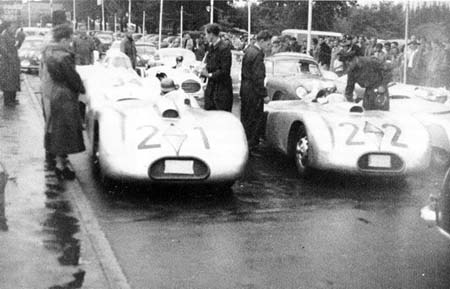
Waiting for the start of the 1.5-litre sports car class at the 1952 Avusrennen: on the front row the two Borgwards of Brudes (21) and Hartmann (22) together with the Porsche Special of Richard Trenkel (outside), followed by Rosenhammer's special DAMW streamliner (34) with its fully enclosed cockpit.
Competition gets tougher (1952, pt.IV)
Meanwhile on the intra-German stage it was another picture. The team had appeared confident at the Nürburgring for the Grand Prix weekend after After Rosenhammer's Avus victory, but the first appearance of the new Mercedes 300 SL on home ground attracted the crowd's full attention. So in the 1500cc class it was hardly noticed that Straubel lost time after a spin, with Rosenhammer finishing third, beaten by Paul Pietsch in his ancient Veritas RS and Hans Hugo Hartmann in the new Borgward.
Only six cars took the start at the Grenzlandring, among them all of the hot contenders: two Borgwards driven by Hartmann and Adolf Brudes, Pietsch's old Veritas RS and of course the two DAMWs. But after a very entertaining race only three cars lasted to the finish, where the order was Hartmann in front of Pietsch and Straubel.
The season ended with a second race at the Avus, announced as an "international" event. This time the Rennkollektiv concentrated on their "national" Avus winner only, whose streamliner was fitted with a fully enclosed cockpit hood. But even this was not sufficient to beat the ultra-flat Porsche Special of Richard Trenkel. Rosenhammer had to be content with second position during the opening laps, which he retained until his engine failed due to a broken drive-chain. Trenkel could not enjoy his unchallenged lead until the end, because he himself ran into engine problems, so that Hartmann (Borgward), Glöckler (Porsche Special) and Brudes (Borgward) were able to beat him into 4th place.
EMW/AWE-Rennkollektiv
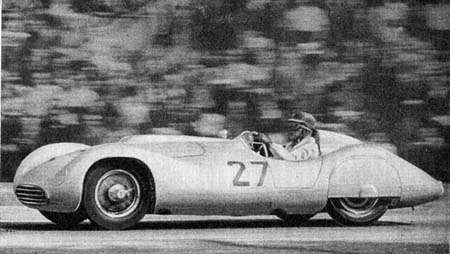
The 1.5-litre EMW sports car in its elegant new shape of 1953, driven by Arthur Rosenhammer.
Year of change (1953, pt.I)
At the beginning of 1953 the Rennkollektiv was incorporated into the EMW company to become the official racing department of the factory, all of this "due to organization reasons". Remember, the EMW factory was now under full German control again. This allowed the Rennkollektiv to be positioned closer to the Eisenach factory, which seemed necessary in order to achieve more success than in previous seasons, when expectations had not quite been fulfilled. The name of the team was changed into EMW-Rennkollektiv and moved to Eisenach, where the cars were completely overworked by the design team around chief engineer Walter Gerstenberg and mechanic Stefan Dudys.
Their main concern lay with the improvement of road-holding and stability, especially at the front, where additional upper wishbones were added in order to relieve the transversal leafspring of its suspension function. The rear suspension was slightly stiffened too, but generally it still very much resembled the old BMW 328 style. Besides that the power output of the engines was increased (now to around 135hp for the 2-litre machine) and two of the 1.5-litre sports cars appeared with new neat bodywork, which can be seen on the picture
With competition having seized in the 2-litre sports car category the driver line-up of the Rennkollektiv looked like this. Of course the best drivers were chosen to represent the GDR in the prestigious races on West German soil. So Barth was given the team's sole Formula 2 entry as well as one of the new 1500cc sports cars. In the latter category he was accompanied by Rosenhammer, who also campaigned the car in the East German series. There Barth fully concentrated on the Formula 2 car, opening a chance for promising talents to shine in the cockpit of the second sports car on a race-by-race basis.
In the season-opener at Karl-Marx-Stadt (the former Chemnitz) this car was given to newcomer Otto Reichert, who had to retire with a broken differential. But Rosenhammer in the second new car was able to make up ground on the Formula 2 field, which had started with a one-minute advantage. In this category Edgar Barth had of course set fastest practice time and he also took an early lead at the start, which he maintained until he had to retire with magneto damage. Thus victory was inherited by Krause, while Rosenhammer overwhelmingly won the 1500cc sports car class.
The following Eifelrennen was marked by heavy rain and Barth and Rosenhammer had to face strong competition in form of the improved Borgwards driven by Brudes and Hartmann and from Helm Glöckler's brand-new prototype factory Porsche. The latter gave a good foretaste of things to come when he achieved an instant debut victory in front of the two Borgwards with Rosenhammer only in 4th place.
But at least the EMW team had another iron in the fire for the Formula 2 race. Barth had qualified his faithful Intertyp in a position on the second row in a field of strong international opposition (see the picture in the West German Specials section). In the race he stood no chance against Graffenried's latest Maserati, the HWMs of Frère and Collins and one of the superb Ferrari 500s of the Swiss Scuderia Espadon in the hands of Kurt Adolff. Barth nevertheless drove a consistent race and inherited 5th after the retirement of Klenk's Veritas Meteor, a position that he held until the end of the race. At least he had driven the best-placed German car and finished ahead of Stirling Moss in the Alta Special, a feat not many German drivers can be proud of.
A week later the Paul Greifzu memorial race was held at Dessau, in reminiscence to the great amateur driver who had lost his life here in the previous season. With some opposition from across the border – Stuck, Heeks, Helfrich and the obscure Willi Sturzebecher – Barth could again press his marks on the competition and duly won the race from Stuck, while the result of the second EMW driver, Werner Jäger, is not handed down to posterity.
At Halle it was the same picture, Barth in front of Stuck, this time with Paul Thiel in the other EMW in fourth position. Rosenhammer, who had already won the two races at Leipzig and Dessau, was held up by a long pit stop in the sports car race, which was again run simultaneously. So the class victory fell unchallenged to West German Richard Trenkel and his Porsche in a race of only three cars, as the second EMW had not made it to the start due to practice damage.
Technical problems marked the EMW effort in the 1500cc class at the traditional Avus race, too. Due to their worn-out material both cars were plagued by technical problems and Rosenhammer achieved a single practice lap. Barth did a little better but his engine was not in good condition either. It is reported that the cars could not be repaired properly in time for the race due to the lack of materials.
In spite of that Rosenhammer made a good start into the race, but then his car only lasted until the fourth lap. Barth at least made it to the line, three laps down but still in 4th position, while at the front this time Klenk in the Borgward had made his way past the works Porsche of Herrmann.
In the Formula 2 run Rosenhammer had to be content with the open-wheeled Intertyp, clearly a big disadvantage on this high-speed track, while the team had decided in favour of Barth for the streamliner. In spite of that Rosenhammer set fastest lap during first practice but in the final session the expected order was restored with Jacques Swaters in the yellow four-cylinder Ferrari of Ecurie Franchorchamps gaining pole position ahead of the green Cooper-Bristol of Rodney Nuckey.
These two also fought over victory until the Englishman sustained an engine failure shortly before the end. The two EMWs, which had been in 4th and 5th position right after the start, were already out after the fourth (Rosenhammer: differential) and sixth (Barth: clutch) lap.
After these disappointing results it was Illustrierter Motorsport's turn to react angrily:
"It is no secret that our privateer drivers have problems… But from our cars of the volkseigene industry one can expect that if they actually take part in the races they should get all the support that the racing department requires. It is not acceptable that provisional parts [probably meaning the old race cars and especially the engines] have to be used, of which there is no certainty that they are able to withstand the demands of an international race. It has been frequently proven that - regarding technical development - the cars have good chances even compared to international standard, perhaps not for top positions, but at least for respectable results… The Ministry of Engine Building (Maschinenbau-Ministerium) along with the Public Committee for Body and Sport (Staatliches Komitee für Körperkultur) will now instantly have to consider how the disgraceful result of the Avus race can be corrected. This might be possible without any problem, if this super-bureaucratic way… will be ultimately cut through."
There probably could have been no better indication of the problems by which the East German state and its economy were already haunted than these words of harsh criticism, appearing in an official magazine only a month after the East Berlin riots of June 17. Looking back it seems that the reason for criticism may not have been simply a lack in technological potential or craftsmanship, as in some areas the GDR was indeed able to keep up with the international standard, but were rather to be found in the poor coordination of all activities within the centralized economy in which even small planning errors could have great effects on the final outcome.
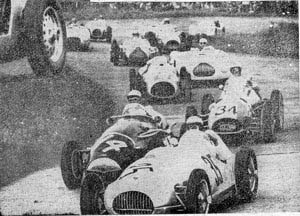
A historic photograph: the only ever attack of Socialism and a state-owned racing team on the world championship, with Edgar Barth in the EMW (35) leading the backmarkers into the first lap of the German Grand Prix in 1953. Following him are "B. Bira" (14, Connaught A-Type), Kurt Adolff (34, Scuderia Espadon Ferrari 500), Hans Stuck (21, AFM 50-Bristol), probably Theo Helfrich (Veritas RS-BMW), Ernst Klodwig (Eigenbau Heck-BMW) and an as yet unidentified car. The Veritas RS on the top left side of the picture might be the one driven by Oswald Karch (or perhaps Wolfgang Seidel?) with probably Erwin Bauer in the much-modified Veritas Großmutter Special behind him. The hazy streamliner at the back should be Karl-Günther Bechem's self-converted AFM 50-BMW sports car rather than Ernst Loof's new Veritas-Nürburgring RS.
A World Championship event (1953, pt.II)
After the Avus defeat the following East German event at Dresden was certainly a welcome occasion for the East German stable to take a breathe and regain some confidence. Barth left no doubt that he was the leading driver of the GDR by breaking Greifzu's 1951 lap record during practice and scoring an outright victory, which also gave him the lead over Krause in the championship.
At that time the traveling radius of East German drivers was limited to the states of the Eastern Block and West Germany, certainly because of political reasons or simply currency problems. So their only chance of breathing the air of a World Championship event was the German Grand Prix at the Nürburgring. In 1950 it had been still a non-championship Formula 2 event and the 1951 race was run according to Formula 1 rules only. Then in 1952 the Rennkollektiv had prevented themselves from taking part by adopting their strategy to concentrate on the 1500cc sports cars only. But with the decision to campaign in the West German Formula 2 classics again in 1953 finally the chance opened up for an official socialist "works" - respectively "state" - driver to take part in a World Championship event for the first (and last) time ever.
Of course with the latest results in mind and the works teams of Ferrari, Maserati, Gordini, Connaught plus a collection of competitive Coopers present, no one could expect the EMW to play a major role in that race. The more realistic aim was to gain the honour of bringing the first German car over the line, which Barth had already done at the Eifelrennen. This would be hard enough to achieve anyway because of the mere format of the race. A World Championship race had to fulfil the requirements of such an event. Thus the race was scheduled for 18 laps, which were no less than 410km, quite an enormous distance under the conditions of the German post-war scene, and certainly very long for the ancient and worn-out BMW engines.
But first the race of the 1500cc sports cars had to be run. It was the well-known constellation again, the factory Porsches of Hans Herrmann and Helm Glöckler being clear favourites together with the Borgwards of Karl-Günther Bechem and Theo Helfrich, with Rosenhammer's EMW playing only an outsider role.
In fact Herrmann took the lead immediately with Bechem, Glöckler and Helfrich close behind, followed by Rosenhammer. And with the exception of Glöckler, who retired on the fourth lap, this remained the order until the cars crossed the line for the final time.
Then it was time for the highlight of the weekend, the Formula 2 Grand Prix race. Barth had done well in qualifying on Friday, where he had fulfilled expections by setting the fastest practice time of a German car. But on Saturday he suffered from an engine failure so that he fell down to 24th spot on the huge 33-car grid.
The engine was replaced overnight so Barth could confidently take the start. At the end of the first lap the bundle of Ferraris and Maseratis at the front was miles ahead. Barth crossed the line in 20th position behind the leading German cars of Herrmann (11th) and Heeks (15th), both on Veritas Meteors, but at least he had passed Fitzau's AFM, while of the further Germans Stuck (in his Bristol-powered AFM) and Loof (in the latest Veritas) had already retired.
But then Barth began to lose ground on his rivals. First he was overtaken by Helfrich's Veritas and then by McAlpine in the Connaught, who was catching up fast after an early problem, and despite his re-passing of Helfrich on lap 10 his engine soon ran into piston trouble which forced him to retire on lap 12. So the laurels for the best-placed German car fell to Herrmann's Veritas Meteor, finishing 9th, while Rudi Krause in the Greifzu Special had been the best of the East Germans in 14th place. All these had finished at least one lap behind the winning Ferrari and Maserati quartet of Farina, Fangio, Hawthorn and Bonetto.
What remains is this short quote from an article from Illustrierter Motorsport after the Grand Prix weekend, which gives some anxious concern over developments in the 1500cc sports car category.
"In the 1.5-litre class something spectacular is developing… What we noticed was a new, and anxiously guarded Porsche car which was worked at, and which bonnet was opened, only when the roller blinds of the box had been lowered. The author himself, who normally has a good contact with the Porsche people, was turned away most friendly when he came too close to this new Porsche creation… The designer and close co-worker of Porsche, Dr. Fuhrmann, was silent like a grave and Huschke von Hanstein, Porsche's race director, only gave a sly smile when somebody tried to entice him into giving a few details on the car."
So at least the men of the EMW-Rennkollektiv knew that they had to prepare even better for the next season…

The rear suspension is about to fail on Barth's new EMW monoposto during practice for the race at Bernau in 1953.
The late bird (1953, pt.III)
After the German Grand Prix it was almost business as usual when the local scene turned its attention to the most important East German race of the season at the Sachsenring. This year the event had gained some kind of "international" character with the participation of Pavelka's Tatra in the Formula 2 race and the appearance of some Skodas in the minor sports car classes.
In the 1500cc class the GDR drivers were among themselves again. All attempts had failed to invite factory entries from Porsche and Borgward and when second EMW driver Reichert had to withdraw in favour of Rosenhammer, whose engine had broken down during practice, it became a very boring affair yet again, with no challenge at all from the rest of the East German dabblers.
However, in the Formula 2 race Barth had the chance to prove that the EMW had indeed developed into the most competitive car of German design, perhaps with the exception of Klenk's revamped Veritas Meteor, as Illustrierter Motorsport generously admitted. Stuck's AFM (which, as was emphasized, was now running a British Bristol engine) and the Veritas RS of designated West German champion Helfrich, who in the past had achieved some fine results in the East German races, no longer seemed a match for the state-owned EMW.
As usual the two main classes were run in conjunction again, with the sports cars being released one minute after the Formula 2 field. Barth had jumped the start, so he had to back off in order to avoid disqualification and Krause and Stuck were able to pass him. After lap 3 Barth took over the lead and maintained this position with increasing distance to his pursuers until the end of the race. Second place fell to Krause, followed by Stuck and Pavelka in the 2.5-litre Tatra, which seems to have participated hors concours. The second EMW, driven by Werner Jäger, already retired on lap 9.
With these results the GDR championship was decided. It was no surprise that it had become the expected EMW success, Barth winning the title from Krause in the Formula 2 category and Rosenhammer becoming a superior champion in the sports car category.
But the East German season was not finished yet. At the last race at Bernau the Rennkollektiv's very first true single-seater, which had been announced all year, actually rolled from the transporter. The car was based around the old faithful BMW 328 engine. The main improvement in comparison to the previous Intertypes – besides the neat and much more slender centrally-seated bodywork – could be found in the rear suspension of the car. Whereas all DAMW and EMW cars before had used the old live rear axle system of the original BMW design (of course with minor modifications in 1953) the design team had now swapped to a de Dion layout. Further changes concerned the use of torsion bar springs but besides that the car followed the main chassis principles of the previous Kollektivwagen.
The entry at Bernau was clearly designated as a test run for the new car, at least after Barth suffered from a rear suspension failure during practice, which fortunately has been recorded photographically in the picture above.
This meant that Barth had to use another car for the race, which put yet more oil on the fire in an already upset atmosphere within the team. Before the race it had been decided to give the newcomers a chance so frequently postponed that season, when (East German) championship points had been at stake. But without a 1500cc sports cars run here it seems that Rosenhammer was not content with his role as a spectator and so he claimed that facing the strong West German opposition (in the form of champion Theo Helfrich, Hans Stuck and Oswald Karch!) it was absolutely necessary to put the "first row of our race-driving elite" against "our West German friends" for this "friendly comparison of powers". So in the end he was installed in one of the cars with the predictable effect on team harmony. Paul Thiel and Werner Jäger had to watch Barth, Stuck and Rosenhammer (in this order) set best practice times, followed by Krause in the Greifzu Special and West German Kurt Ahrens with his 1100cc twin-cylinder Cooper-JAP.
The race developed into a real duel by hook or by crook between the two EMW drivers. Rosenhammer had slightly missed the start, but before the end of the first lap he was already up in second spot again, some 150 metres behind his team-mate. Barth's lead melted away like butter and on lap 3 Rosenhammer was in striking distance. Time after time the two EMW drivers passed by the grandstands in close formation until the very last of 14 laps, when Rosenhammer finally shot out of Barth's slipstream and into the lead. Barth countered immediately and re-passed again, but by doing so he left his foot down too much, with the consequence that his car spun on the Kurve der Jugend (Turn of the Youth). So Rosenhammer won the race one second ahead of his rival, who seems to not have been amused by this outcome. Illustrierter Motorsport (of course under co-edition of Rosenhammer) consequently wrote:
"We do not want to decide whether it had been due to experience or sheer luck that Rosenhammer won this race. But one thing is certain: our beloved Eddy Barth, whom we have learned to be a kind comrade and a sportingly fair man so far, has shown himself a bad loser. Every man has nerves. Eddy Barth lost them perhaps for the very first time at Bernau. It is not only our wish, but perhaps that of the whole racing community, that drivers who belong to the Eisenach collective will always show enough fellowship to overcome internal defeats. Both, Arthur Rosenhammer as well as Eddy Barth, will hopefully achieve many further successes for the democratic sports movement. Experience teaches us that it is hard to succumb. Let us hope they will learn something in this domain, too, at the collective."
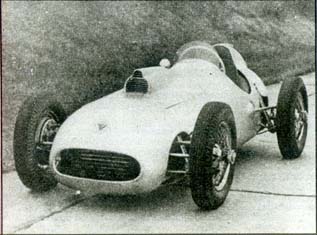
The reason for the preservation of a whole Formula: the EMW monoposto.
Year of reprieve (1954, Pt.I)
After the last race of 1953 the members of the Rennkollektiv suddenly woke up and recognized that with the development of their new monoposto they had entered a dead-end street. The car appeared too late to be run seriously in 1953 and from 1954 onward the 2-litre Formula 2 was no longer valid, as it was replaced by the new 2.5-litre Formula 1. And with automobile concerns like Mercedes having already announced their serious engagement to the new formula there would be no chance to campaign an old 2-litre car at a competitive level.
All of this wasn't surprising at all, as the rule changes had been announced years before. Preparing for them would have meant producing a completely new engine, as the BMW six-cylinder had long reached its limit of development. The East German press began to deliberate about this necessity early in 1953. In fact some articles gave some paraphrased statements that such a project was already in the queue at Eisenach.
Obviously the men in charge soon realized that the effort would lead beyond the economic and material limitations of the team. Instead they were forced by circumstance to maintain a hand-to-mouth policy and make the best of what was at hand – the old BMW 328. Perhaps there was some hope that new resources would be opened up by the authorities in case they could finally record some success with the old machinery. A condition for that was positive press which emphasised the achievements of the team and permanently speculated about the chances that would open up in the future. Exaggerated announcements instead of true achievements – regular symptoms in all totalitarian systems.
As a consequence much power and time was wasted in long deliberations and discussions during the winter of 1953-'54, instead of concentrating on the work for a new design. The articles in Illustrierter Motorsport were lamenting on how the FIA could have come to introduce such a "misleading" formula which would not be useful for the development of serial-production passenger cars at all! "… and this just at the moment when our investments into Formula 2 designs, which have just been developed beyond a provisional state, begin to pay out. …This will lead to factory teams, directed by the ice-cold dispositions of their racing strategists, fighting among themselves to the end in an absurd battle for the sale of automobiles, which only have the company's name in common with the race cars used in that fight. The amateur who keeps up the ideals of the sport will be forced back into the role of an also-ran."
This passage clearly aimed at Mercedes-Benz. It ended with some warning sentences:
"In 1934 to 1939 the politicians were racing! In 1954 the industrial concerns will race!"
Facts which of course were totally neglected by the ever-stubborn FIA…
The final outcome was the quite bashful decision to extend the old 2-litre Formula 2 for another year in a national solo run. This had of course suggested itself, following the adopted principle of the team (and the whole state) not to waste anything, especially not a car, which had been developed with such an amount of resources as the monoposto.
But taking this direction also meant that the GDR made its first step into separation from international motorsport, which would be followed by many further ones (for example the general ban on private race car imports, which was enacted in January 1954) which happened everytime it seemed to be impossible to keep up with the general standard, finally leading to total isolation of the Eastern scene.

Rosenhammer's new EMW 1500cc sports car at its first outing at Leipzig in 1954. In spite of the poor picture quality the photo gives a good impression of how low the lines of this car really were.
New deal (1954, pt.II)
The parsimony of the Rennkollektiv had a reason. The team management had finally recognized that in order to achieve success concentration on a single serious effort was necessary – and a completely new design.
According to propaganda principles and probably also for financial reasons the choice again fell upon the 1500cc sports car class. Under great secrecy, which was not too hard to achieve in a totalitarian environment, work on the car began.
The chassis was a completely new development, a combination of an aluminium tube-section frame with spaceframe components mounted to it. Torsion bars were installed instead of the usual leaf springs, as had been already a feature of the 1953 single-seater, from which the de Dion rear axle was also adopted.
In spite of using the well-known block of the BMW 328, which in its 1500cc version did not appear to have such an extremely long stroke at all with its 66x73mm dimensions, the whole rest did not have much in common with the previous engines, so that we can regard this as an almost completely new design too. Clear indication of this was the introduction of a DOHC layout and double ignition. Another important step forward was perhaps the switch towards the use of horizontal carburettors (initially one for each cylinder, in motorcycle style), which resulted in a better airflow on the inlet side and allowed a much lower silhouette than the one we had been accustomed to previously on the various BMW 328 derivatives.
This advantage was transposed with the highest possible consequence, so that the car caused a real sensation, at least among the experts, at its first public appearance at Leipzig in 1954. The highest point of the car (at the driver's headrest) was only 90cm and the body in front of the cockpit was down to 65 cm above the ground! The "R3" as it was named internally (which suggests that the Intertyp and the Monoposto had been the "R1" and "R2" respectively) weighed in at a sensational 470kg. With its power output of about 110hp at 7000rpm and its neat finish it caused much applause in the local press as a masterpiece of true workmanship.
And there was yet another novelty at the beginning of 1954: after the failure of the East German leaders to propagate a reunited "free" Germany outside of the military alliances in the early fifties the new political course was to lay a foundation for a national identity of the GDR itself, which they perhaps also tried to express by adopting a national race colour of their own. At least the EMW cars did not appear in the familiar silver or white anymore but in a very bright shade of ivory yellow. In 1956 this colour scheme was further improved by the addition of some drop-shaped red spots around the lights and wings, which made the cars appear much more "racy".
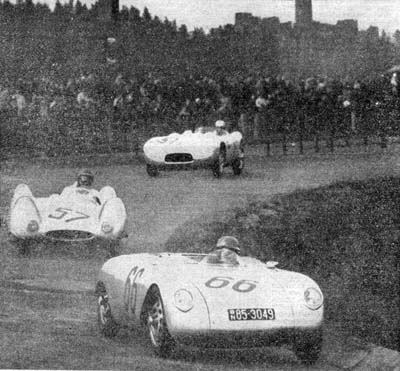
Three of the main contenders in the 1500cc sports car race of the Eifelrennen weekend in 1954: Richard Trenkel (66) in his self-built Porsche, Arthur Rosenhammer (57, EMW) and Adolf Brudes (51, Borgward). A good occasion to compare the EMW's low lines to the other cars. One really wonders how there could be enough room for the engine beneath the bonnet.
A serious attempt (1954, pt.III)
Rosenhammer was given the honour to give the car its debut at Leipzig, backed up by Thiel in the older 1953 model. This time some opposition from West Germany appeared in form of Niedermayr's privately entered Porsche. In the race Thiel had to retire early on lap 3 with an engine failure and Rosenhammer, despite being in the lead, was plagued by some teething problems of his car when one of his six carburettors quit duty. So Niedermayr was able to take over and win the race while Rosenhammer at least succeeded in salvaging second place over the line.
Only a week later the season really started with the Eifelrennen at the Nürburgring, where the new car had to face the strongest possible opposition in form of the works Porsche of Hans Herrmann and no less than three of the now fuel-injected factory Borgwards, driven by Karl-Günther Bechem, Adolf Brudes and Hans Hugo Hartmann. From Italy there were three OSCAs and last but not least the race saw the appearance of a certain Colin Chapman in his Lotus, who arrived too late to absolve the required practice laps and consequently was asked to hand over his car to German driver Erwin Bauer.
It seems the team had forgiven Barth his "escapade" at Bernau, as he was chosen as Rosenhammer's team-mate. But in spite of the best available driver line-up practice made clear that any good result would be prevented by the cars' weak point, as it was impossible to tune the six motorcycle carburettors properly.
Knowing this it was surprising that Rosenhammer was able to move up into fourth position in the race before he had to retire due to a clutch problem. Barth, whose car at least lasted to the line, had to be content with a disappointing 10th place. The race ended with a double victory for the Borgward factory, Bechem followed by Hartmann, after the leading Porsche of Herrmann had crashed out of the race, with the next places being awarded to Giardini in the OSCA and Bauer in the exotic Lotus "Eigenbau"…
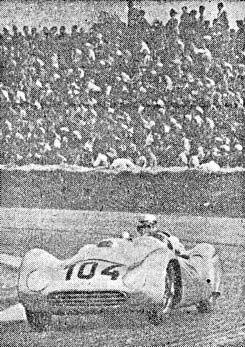
Paul Thiel in the 1500cc EMW sports model of the previous season, fitted with a 2-litre engine for the Formula 2 race at Dresden in 1954.
Last breaths of a dying formula (1954, pt.IV)
Back home the Rennkollektiv had to face other problems: the privateers had listened well to the arguments of the East German officials in their damnation of the announced engagement of the West German factories in Formula 1. Now they stated that they were in fact the ones who incorporated the true sporting spirit and complained that the Rennkollektiv was competing them on a very different level in the national championships. As a solution it was suggested - and after a public dispute in Illustrierter Motorsport finally accepted - that points and prize money of each race would be awarded separately for works drivers and privateers. This meant that the best non-works driver would score full points and get all of the money in every case, while the works drivers would only be rewarded for their actual overall position! Perhaps this could also be regarded as a form of punishment by the motorsport officials for the disappointing results of the Rennkollektiv so far. Of course the works drivers looked at this decision from a very different angle.
During winter two driver sightings had been held to find the line-up for the new season in the East German series. Rosenhammer and Barth's positions were of course unquestionable, but the other candidates - Otto Pohlan, Hellmuth Laue, Linke and Kurt Schulze - did not impress too much. In the end Laue was chosen to campaign the local Formula 2 races alongside the more experienced Paul Thiel.
But - perhaps in order to give the stars of the team an occasion to shine without causing new anger among the reserve drivers - the Rennkollektiv appeared with no less than four entries in this class at Dresden. To materialize them virtually every car that was at hand had to appear. Barth was of course the man to give the new single seater Monoposto its race debut while Laue appeared with the standard Intertyp in which Barth had won the race at Bernau in 1953. In addition to that the team used the opportunity to give Rosenhammer a test run in the new 1500cc racer, which was now fitted with three twin carburettors. But perhaps one of the best examples for the urgency to make as much use as possible of the available machinery is perhaps the picture above, which shows that the obsolete sports car of the previous season had not been simply thrown away but turned into something useful by installing one of the available 2-litre engines, thereby producing the last "new" Formula 2 design. So in this collection of four different race cars all the design layouts the Rennkollektiv had developed so far were represented!
In order to show a good performance the Rennkollektiv had held a two-day preparation programme at the factory's own test track, where the new 1500cc machine turned out to be fastest, despite giving away some 500cc of engine capacity.
But as almost inevitably happened when the Kollektivfahrer clashed, especially with Barth and Rosenhammer in one race, their internal rivalry broke out again. Rosenhammer in particular tried to compensate with his right foot what his engine lacked in power. The result was that in the first practice session Barth, Laue and Rosenhammer had all over-revved their engines. In fact Barth had not even been able to set a single timed lap at all! Only Thiel had kept himself under control and qualified his old car on the front row of the grid alongside Rudi Krause.
It was also Thiel who took the lead right at the start, followed by Krause, Laue and Barth, who had been allowed to start from the back of the grid. But in spite of the injured engines having been repaired overnight the dying soon began. The first retirements were Barth and Laue and soon Rosenhammer began to drop back too. The EMW fiasco was complete when Thiel's engine started to run on five cylinders, allowing Krause to pass and win the race. Thiel was able to finish second while Rosenhammer nursed his car home in 5th.
The outcome of this race had been a real catastrophy for the team and the shock was deep indeed. After that the Rennkollektiv stayed away from the event at Rostock completely, even if this opened up the way for a five-way Porsche victory on East German ground in the sports car race. And it was perhaps not too unwelcome that the following race at Dessau was cancelled when the near-by river had flooded the race track.
But they simply had to appear for the Grand Prix weekend at the Nürburgring, especially as this time the 1500cc race carried the title of "German Grand Prix", the Formula 1 race being run as the European Grand Prix in 1954. And things seemed to develop out surprisingly well when Barth was credited with fastest practice time! But the organizers soon discovered the timekeeper's error and Barth was pushed back to 8th position on the grid behind four factory Porsches, an OSCA and the two Borgwards. In contrast to that Rosenhammer had not been able to complete the required three practice laps because of a gearbox failure and was banned to last position in a field of 27 cars.
The Porsches were already forming a class of their own and recorded an overwhelming 1-2-3-4 finish in the order Herrmann-von Frankenberg-Polensky-von Hanstein. Best EMW driver was again Barth, who finished an unexpected 6th behind Bechem in the Borgward. 12th was Thiel in last year's car while Rosenhammer, in spite of making up ten positions at the start, had not even completed a single lap.
Only a week after the German Grand Prix the next East German event took place at the Halle-Saale-Schleife, where the Formula 2 race turned into a true farce. After an unpleasing early-morning test run on the Autobahn the Rennkollektiv had decided to withdraw again, but at least they kept their entries for the sports car race. There Barth had to push-start his car but in spite of that he found himself in the lead at the end of lap 6! This of course inspired Rosenhammer, who immediately fought his way into second position past Trenkel's private Porsche. But the West German was able to counter and so the order at the end was Barth in front of Trenkel and Rosenhammer.
After the results at the Nürburgring and Halle the EMW crisis seemed to have been overcome just in time for the race at the Sachsenring – as ever the highlight of the East German season. The importance of the race was underlined when the organizers were able to attract a Porsche factory entry. Race director Huschke von Hanstein himself qualified the car on pole alongside the two EMWs of Rosenhammer and Barth, with the usual phalanx of private Porsches and the third EMW – Laue's 1953 model – behind.
With a clear advantage in power and road-holding von Hanstein pulled away from the rest immediately, while behind him Barth found a way past Rosenhammer on lap 5. This remained the order until the end of the race with Niedermayr in his Porsche being the only one not to be lapped by the three leaders. Together with Laue's finish in 7th place, again this was not a bad result for the EMW team.
In contrast to the entertaining sports car race the Formula 2 run was again disappointing. Only six cars formed on the grid, but at least this time two of the Kollektivwagen were among them again. Thiel in his old faithful Intertyp fulfilled expectations with his first Formula 2 victory, which would turn out to be the last of the Rennkollektiv, but 100kg man Perduß in the cockpit of the slender Monoposto did not come to terms with the car and retired after a spin.
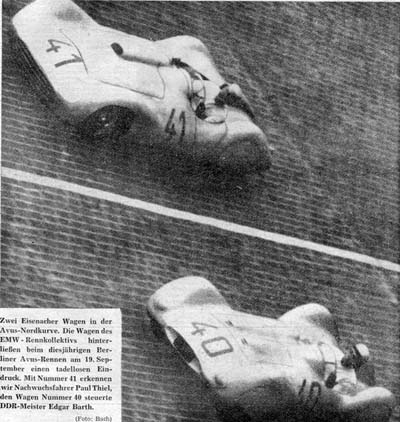
Two EMWs taking the banked Nordkurve of the Avus track in 1954. No.40 is GDR champion Edgar Barth in the lowline 1954 car, while Paul Thiel (41) has to be content with an elder model from the previous season.
Tragic end (1954, Pt.V)
After a short interlude at Brno, where Barth and Rosenhammer had been entered in their 1500cc sports cars against two 2.5-litre Tatras (Rosenhammer finishing second behind Pavelka while Barth retired) and after the new cancellation of the race at Dessau – this time due to a date clash with the Leipzig fair, for which the race track's part of the Autobahn had to be kept open – the season gradually neared its end with the races at the Avus in the West and at Bernau in the East.
With their newly regained self-confidence the EMW team appeared with a full three-car entry at the Berlin high-speed track, as Thiel was again allowed to support the two star drivers of the team with his 1953 model in order to gain some international experience.
Just as at the German Grand Prix the factory Porsches were in a class of their own with Herrmann on pole position and von Frankenberg second. But behind them the EMW team achieved a very impressive result with positions 4, 6 and 7 on the grid, while the Borgwards were suffering from their long-stroke engines on the long fast straights and fell clearly behind the cars from Eisenach during practice.
After the start Rosenhammer was able to keep a very pleasing third position until his car caught fire on lap 4. Luckily he escaped unhurt, but the place on the podium was lost as Barth was unable to catch up with Bechem in the Borgward after having spun two times earlier in the race. Thiel finished respectably again in 7th place.
So the drivers of the Rennkollektiv could return to the GDR with their heads held high for the last race of the season (and the last of Formula 2 altogether as well!) where their national championship was to be decided at Bernau. According to the new scoring rules for privateers and works drivers Rosenhammer had scored only 16 points in the 1500cc category so far, while Melkus appeared with 18 in the bag in spite of not having won a single race with his almost antique ARO-Veritas. Barth, who had not taken part in the race at Leipzig, had collected 13 points for his results at Halle and at the Sachsenring. The Formula 2 table was clearly led by Krause on 19 points with EMW driver Thiel in second place with a total of 12. Each of these drivers had a chance of winning the championship in his class, as in addition to the 6 points for victory (or at least being the best-placed driver of the GDR) it would have been possible to score an additional point for fastest lap of the race.
With the experience of the small Formula 2 field at the Sachsenring in mind it was decided to start both classes in a combined race, as it had been usual in the previous season. EMW had brought along their usual driver line-up with Barth and Rosenhammer (whose car had been repaired from its fire damage) starting in the sports car class, while Laue was entered for the Formula 2 race again.
Rosenhammer led the race during the first nine laps, but then he ran into trouble with his clutch and once more Barth was able to pass him. Surprisingly it was Egon Binner in his Eigenbau-BMW, who led the Formula 2 field with Thiel only in fourth position because of some problems with his car, and he was about to lose the championship. But then all of this turned out to be fairly unimportant when Richard Trenkel lost control over his Porsche on the 10th lap and killed three race officials in the inevitable crash. The race was stopped immediately and the results were declared in accordance to the order after nine laps, which put Rosenhammer back into first place in the sports car class - of course another reason to get into trouble with Edgar Barth's supporters! Anyway, the race did not count towards the championship, as it had not been of the required length. This led to the curious situation that according to the rules, with only three races run, no title could be awarded in either category! Thus Rosenhammer and Krause had to be content being declared DDR-Beste ("best of the GDR").
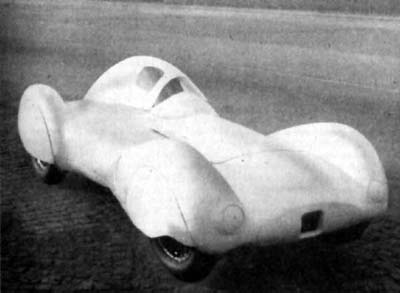
The 1954 EMW world record breaker.
"The fastest unsupercharged car of the world" (1954, pt.VI)
With the epic pre-war efforts of Mercedes and Auto Union on the Autobahn still well remembered and the Borgward factory also having just achieved class records over 50, 100 and 200 miles and kilometres (with an average speed of about 220km/h) the managers of the Rennkollektiv recognized a chance for further glory by following these examples with a run on the world speed record. A successful attempt could not only be additional public promotion, it would also be comparatively cheap and easy to achieve, as the variety of classes, categories and distances allowed almost certainly to find a niche where success would be almost certain without too much effort.
A diligent study of the record lists proposed the "flying" 10 miles distance, where the mark stood at 217.8km/h, set by American Leon Duray with a "Packard-Cable-Special". Soon a purposeful place was found in form of a new high-speed Autobahn section at Dessau.
After these decisions work on the record breaker began at high pressure. In order to avoid unsuitable weather conditions the whole effort had to be carried out before winter set in, so it was only possible to carry out a very limited development programme. In spite of that the convincing result can be seen on the picture. It in fact shows one of the existing 1500cc sports cars, only fitted with some simple aerodynamic improvements like the fully covered wheels, a mask for the radiator grille, a canopy for the cockpit and some other minor modifications on the rear bodywork.
Because of some of the usual bureaucratic delays – the public traffic had of course to be blocked at the track – it lasted until December 3rd before the event could finally take place. As a consequence there was a bumpy wind on "race" day and the conditions were far from being ideal. An additional problem posed the actual length of the high-speed track: a mere 14km. So in order to extend it to the required 16.09km it was necessary to use a normal part of the Autobahn, which contained a forest passage and a long curve, and everybody still remembered the circumstances of Rosemeyer's fatal accident in 1938. But the weather forecast for the next few days was even worse so the decision was made to start anyway.
According to the rules the 10 miles had to be run twice within one hour in both directions. Then the average of both runs was to be calculated in order to determine the official record speed. And right away in the first attempt Rosenhammer achieved 229.5km/h, enough to break the existing record. Then Barth was given a chance and he, too, exceeded the old speed mark, being only a few seconds slower than Rosenhammer.
Inspired by this success it was decided to repeat the whole effort again on the next day, now with a new slide bearing engine installed in the car. But the wind had turned even worse, so the runs had to be cancelled. But of course team and management could be very content with what had been achieved. It was an excellent promotion for East German automobile industry and the fact that they had for the first time actually reached one of their goals gave much confidence for 1955.
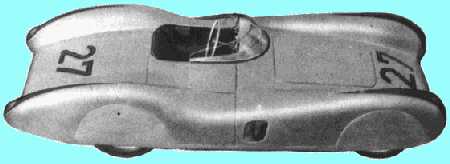
Finally state of the art: The 1.5-litre sports car at the end of its development line in 1955-'56. A good angle to show the much smoother body lines of the 1955-'56 variant in comparison to the 1954 model.
Now or never (1955, pt.I)
The experiments with the record breaker had not only been a great propaganda success but were also of great technical value. One of its results was the recognition that the shape of the 1954 car was as efficient as could have been expected. The wheel covers and especially the fin behind the driver's headrest, intended to give the car more lateral stability, caused a strong sensitivity to crosswinds, so the car was fitted with a flatter and even more streamlined bodywork.
The engine was overworked once again, too. According to some sources it delivered some 135 to 142hp at 7200rpm now, which would have been enough to outdo the Borgward and even the Porsche 550 Spyder. All this was achieved without increasing the total weight beyond 530kg and in combination with the torsion springs and the de Dion rear axle, which had already worked so well in 1954, the car excelled with superb road-holding and was regarded as more than a match for the previous season's factory Porsche 550 Spyder.
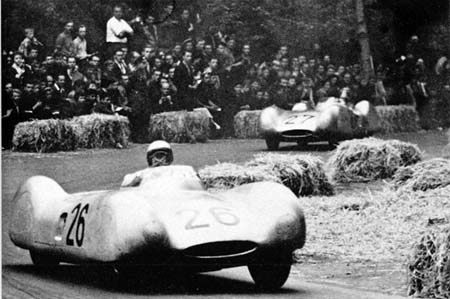
The two leading drivers of the Rennkollektiv, Edgar Barth (26) and Arthur Rosenhammer (27) in their 1955-spec EMW sports cars in a local event at Halle.
Moment of triumph (1955, pt.II)
This was confirmed when Edgar Barth set a new lap record at the Nürburgring during practice for the Eifelrennen wih the sensational time of 10:39.1 minutes, lowering Richard von Frankenberg's 1954 time in the works Porsche by over 15 seconds. Alas, the race took place without any engagement from the West German factory teams, as the development of the new Borgward engine was not yet finished and the Porsche works had decided to stay away for the whole season, concentrating on support for their customers. So von Frankenberg in his private Porsche was the only serious opposition to the four EMW drivers (a proof that the team took things really serious that season) Barth, Rosenhammer, Thiel and 1954 Formula 2 champion Egon Binner.
But to their disappointment the race was combined for the spors car classes up to and above 1.5 litres which meant that only a class win was within range, as the presence of the almighty Mercedes-Benz 300 SLR would leave them no chance for a publicity-attracting overall victory. But even that was endangered when von Frankenberg was able to cling on to the slipstream of the three leading Mercedes and Farina's Ferrari right from the start, while the four Kollektivfahrer immediately lost connection to the leading group when they were involved in some initial mid-field battles.
In order to keep the East Germans at bay von Frankenberg really kept his foot flat to the bottom. He increased his lead over Barth to 65 seconds and with 10:51.9 he set fastest lap of his class. But this was only possible by driving beyond the car's and his own limit and when Kling's Mercedes lost some oil von Frankenberg was unable to avoid the spot and spun into a ditch, into which he was also followed by another competitor. When Barth reached the dangerous place he was barely able to find his way through to an unhindered class victory. The total EMW triumph was completed by Thiel, who finished in second place in front of the private Porsche armada. Not a bad achievement for an engine whose basic design principles reached back some 19 years.
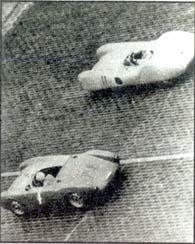
Porsche vs. EMW, battle of the secondaries: Paul Thiel takes the Nordkurve banking above Berlin-resident Swedish Porsche privateer Gert Kaiser in the 1955 Avusrennen.
Life goes on (1955, pt.III)
The Le Mans catastrophy in June had strong effects on motorsport in Germany and in its aftermath the Grand Prix (organized by the AvD club) had to be cancelled. So it was a long gap until the traditional long-distance race which the rival ADAC club had scheduled for the end of August. Even this was not allowed to be run over the full 1000km distance and had to be shortened by half, but at least it could still take place.
In the understandable absence of the "big bangers" the 1.5-litre race was regarded as the main event. But in case the EMW team expected an easy outright victory to fall into their hands like ripe fruit, they soon had to learn they had to deal with yet another adversary, the latest factory Maserati sports car in the hands of Jean Behra. In power and road-holding this was at least on terms with the Kollektivwagen, a fact clearly underlined by Behra's initial lap time of 10:30.5. And when Barth managed to go a bit faster the Frenchman was able to strike back with ease, lowering the record to an impressive 10:27.2. The only remaining question was whether the car would last the distance, as Maseratis were generally infamous for their unreliability, but on the other hand the new EMW had not proven its durability in a long-distance run yet either.
The start of the race happened in Le Mans style with the Porsches of Herbert Linge and von Frankenberg taking the initial lead, but it did not last long until they were overtaken by Behra. Barth and Rosenhammer had again made poor starts, but then they began to make ground on von Frankenberg, who was passed by Barth, still on the opening lap. Now the order was Behra in front of Barth with von Frankenberg in a safe third place, which became second when the EMW engine failed. Rosenhammer was called in immediately in order to hand his car over to his team leader, but his car had already been low on power too, and so the team had to be content with third place at the end, as Behra's Maserati indeed survived the whole 500km distance.
The full four-car team of the Rennkollektiv was brought to the season final at the Avus too, where again the organizers had not dared to open the race for something bigger than the 1.5-litre sports cars. And without Behra's Maserati it was down to the old duel between the East Germans and von Frankenberg, which stood 1-1 at the moment.
With their lowline shape and their tiny frontal area the EMWs seemed to be ideally suited to the track but finally the Porsche factory had recognized what was at stake and agreed to search for some additional horsepower in von Frankenberg's car, which was also fitted with a new five-speed gearbox. But even with this special preparation the Porsche was not fast enough in practice to keep pace with Barth's EMW, who recorded an average speed of exactly 200.0km/h, followed by Rosenhammer with 199.1km/h with von Frankenberg only in third spot at 199.0km/h. But in the race he almost immediately took the lead, with the AWE pack close at his heels in the order of Barth, Rosenhammer, Thiel and Binner. Lap after lap the speed increased, climaxing into an incredible 202.4km/h average by Barth on the 15th lap, and one turn later the whole field had been lapped at least once by the five leaders. But von Frankenberg was still in front as Barth was obviously following Ulmen's 1951 strategy at this very place, intentionally staying behind the leader in order to preserve his car to the last lap. But once again this plan did not work as Barth suddenly had to retire with a broken throttle link on lap 25.
Now it was Rosenhammer's turn and indeed he was able to close the gap to the Porsche again, but it was too late. Von Frankenberg, ducking himself behind the steering wheel on the long straights, managed to salvage his lead over the line, which he crossed six seconds ahead of Rosenhammer, Thiel and Binner, the latter even crashing on the slow-down lap.
Despite being reduced to only three races (plus the obligatory Sachsenringrennen, all I know of that it was won by Barth – of course!) it had been a thrilling season in the 1.5-litre sports car category. In the end the Rennkollektiv had just missed it again, but only close, and their cars had been clearly the ones to beat in this class.
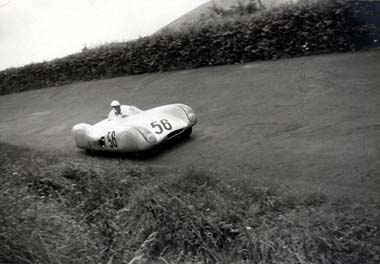
Edgar Barth at the Nürburgring in 1956.
Racing ambassadors (1956)
The year 1956 began with a minor setback for the EMW factory, as after the long legal dispute with the West German BMW concern the company's name had been found to bear too much resemblance and therefore was changed again into AWE (Automobilwerk Eisenach).
Alas, I have found little more than some meagre statistics of the races of this seemingly very interesting last season of the Rennkollektiv. So - especially as sports car races are not my favourite domain at all - I can give not much additional information besides mostly dull facts.
By that time sports car racing had gradually developed into long distance competition, of course a very demanding form of racing, ideally suited to demonstrate the quality of drivers and material. A good example for this was the traditional race at the Nürburgring, which was now run over its traditional length of 1000km again. Two AWE cars started there with the usual driver line-up, Barth/Rosenhammer finishing 3rd in their class behind the two Porsches of von Trips/Maglioli and von Frankenberg/Herrmann (7th overall), while the car driven by Thiel/Binner retired with an engine failure.
Caused by my lack of sources I am not able to tell how the members of the AWE team could overcome the aforementioned traveling hurdles, but this season in fact saw the state's owned race car team from the GDR visit Western European countries on two occasions at least. Barth's biography states that it required quite an amount of paper-work before the Ministerium für Körperkultur und Gesundheit (Ministry of Body Culture and Health) finally gave permission to travel to France for the Coupe de Valvoline at Montlhéry in the region of Paris.
Since 1954 the members of the Rennkollektiv had looked jealously to this high-speed semi-oval track where the West German teams had found nearly perfect conditions for their record breaking attempts while the AWE team had to be content with their patched up part of the Dessau highway. Now, in 1956, they were finally able to visit this legendary place in order to take part in the 1000km race there, which is still remembered today as the all-time highpoint of East German motorsport. To my everlasting regret I do not know anything beyond the pure result (and no pictures!) of this race, in which indeed Barth and Rosenhammer won their class against the strongest of international opposition.
The Rennkollektiv's next stage on its trip across Western Europe was the Supercortemaggiore race at Monza, where things did not quite develop as good as at Montlhéry. Problems started at the Austrian border where transit for the team was denied. The detour via Switzerland was not without complications too, as the transporter was found to be 15cm too wide and 20cm too high for the Swiss traffic regulations. When the team was finally allowed to pass they arrived at Monza in a very bad temper, only to learn that the Italian sports car regulations did not allow the three exhaust pipes of their car…
After these excitements their next disappointment was waiting after practice: Thiel and Binner had failed to make the cut in the team's second car by a tenth of a second, while Barth and Rosenhammer could only take the 41st position among the 65 cars on the grid.
Barth was given the first turn of 40 laps in the race, which he completed with an average of 193.7km/h. Then Rosenhammer took over, but he came in again after only four laps suffering from a broken oil pipe, which took away visibility. This caused a whole series of pit stops, in which Barth took over again, but the problem could not be solved durably and finally the car had to be retired.
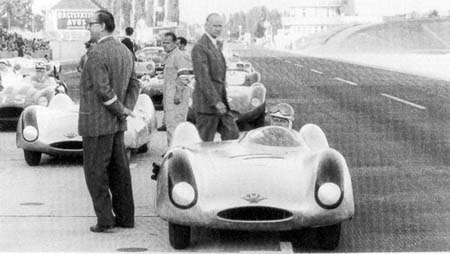
Two AWEs forming up at the head of the field for the grid in the Rennkollektiv's swansong appearance at the Avus in 1956. No.11 is the car of Edgar Barth.
AWE farewell (1956, pt.II)
After the two races in France and Italy the AWE team did not travel outside Germany. Instead they concentrated on comparatively short races where they could enter a car for each of their drivers, like at the Solitude (where Barth finished 3rd behind the Porsches of Herrmann and von Trips), the German Grand Prix support race at the Nürburgring (where Barth retired after a close battle for the lead with Herrmann's Porsche and Binner was their only finisher, but way behind in 8th place) and finally at the Avus (where it was again a Porsche 1-2 victory, this time with Rosenhammer being the man to lead the East German pack in 3rd, with Thiel in 4th and Barth retiring).
These had been the last races of the Rennkollektiv, as the GDR officials gave order to quit the engagement of the state in this very expensive and consuming form of racing at the end of the season. As a consequence the arena of circuit racing was left completely to a blossoming private Formula 3 scene, while the official racing activities concentrated on rallying instead, which was of course much cheaper and regarded to be much more according to the philosophy of being "nearer to the customer" than pure race cars. This was a much better sounding paraphrase than having to admit that the philosophy of "racing as the vanguard of the production series" had not worked - at least not in the GDR. In fact it had been more or less the opposite: The Rennkollektiv was still racing BMW derivatives long after the six-cylinder EMW production cars had been abandoned at Eisenach.
This leaves me to say some words about the fate of the GDR's leading driver, Edgar Barth. With his performance at Montlhéry he had attracted the attention of the Porsche team (if he hadn't done that before) and when the closing-down of the Rennkollektiv became known they made him an instant offer to drive for them in the 1000km race at the Nürburgring in 1957.
Barth was very happy for this chance to continue his career, but as could be expected, East German bureaucracy hesitated to give him permission to accept the Porsche works drive. So Barth, who had already made his precautions, travelled to the West with the intention to take part in a motorcycle race at Hockenheim. In this way he was able to drive at the Nürburgring without the required permission, where he achieved an instant class victory together with co-driver Maglioli in his debut race for Porsche. After that he learned he was banned for life from taking part in any motorsport event within the GDR. This meant he would not get permission for another journey to the West if he ever set foot on East German soil again. So he left his East German possessions behind and looked for a new home, which he finally found at Kornwestheim, in the neighbourhood of the Porsche factory at Stuttgart.
From there he continued his successful career for the Porsche team to take a sensational overall win in the 1959 Targa Florio and successes in the European Hillclimb Championship in 1959, 1963 and finally 1964, before it became known he had fallen ill with cancer, from which he finally died – at the much too early age of only 48 – in 1965.
Appendix A – The rear-engined mystery: Auto Union E Type, DAMW, Sokol & Co.
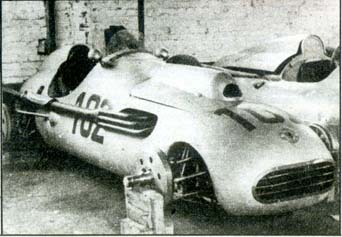
A picture taken inside the EMW workshop, most probably early in 1954. Not so much the Monoposto in the foreground should attract the viewer's attention but rather the obscure rear-engined car in the back…
Besides all the still existing gaps in my knowledge of the DAMW/EMW/AWE efforts this car remains the greatest mystery in the story of East German motor racing.
Is this the rear engined East German Formula 2 car, the rightful successor of the tradition of pre-war Auto Union Grand Prix racers, a last development stage which is reported to have been built and tested (by the DAMW? The Eisenach factory? The Rennkollektiv? The former Auto Union Research and Development center? The Russians?) in the spring of 1952, before it was laid aside when the lubrication problems of its V12 engine could not be really solved? Is it the link to the obscure Russian Sokol, reported to have appeared in a race at Moscow around 1952? And is this the car which is exposed today at the Donington Collection, claimed to be "the" Auto Union E-Type, designed for the inaugural 1500cc Grand Prix Formula of 1941?
Hopefully somebody will soon succeed in discovering the answers to all of these questions and write down this car's true story. As a matter of fact, it is being worked on for 8W right now...
Appendix B – model overview
Awtowelo-BMW
| S1, Intertyp |
|
|
| BMW/EMW 340/1 |
|
Cars of the Rennkollektiv (DAMW, EMW, AWE)
("": designations only for internal use by the author!)
| 1951 | DAMW "R1" |
|
| 1952 | IFA-DAMW "R1/52" |
|
| 1953 | EMW "R1/53" |
|
| EMW "R1/53 Sport" |
|
|
| EMW "R2" Monoposto |
|
|
| 1954 | EMW "R1/53" |
|
| EMW "R2" Monoposto |
|
|
| EMW R3 |
|
|
| EMW "R1/54 Sport/F2" |
|
|
| 1955 | EMW R3"/55" |
|
| 1956 | EMW R3"/56" |
|
Picture sources
- Reinald Schumann: Motorsport in Deutschland 1945-1955
- Copies of old race reports, like issues of Das Auto, but some of them also unknown to me
- Ingo Seiff: Der Schottenring
- Website of Joachim Traber
- Official Website of the new Veritas company
- Riedner: Doppelsieg (Pietsch Biography)
- www.motorracingretro.i12.com, Motor Racing Retro website
- Eberhard Reuß: Grand Prix
- Walter Zeichner: Kleinwagen International
- Werner Oswald: Deutsche Autos seit 1945
- Website of the Auto-Salon Singen auction
- Website of Prova, Magazin für Automobile Avantgarde
- Website of the Society for Revival of the Solitudering race track
- Arthur Rosenhammer, Günther Graßmann: Motorsport Almanach 1953
- Rudi Krause: Zwischen Box und Fahrerlager
- Roger Gloor: Nachkriegswagen
- Werner Oswald: Kraftfahrzeuge der DDR
- Michael Dünnebier, Eberhard Kittler: Personenkraftwagen sozialistischer Länder
- www.bmw-modelle.de
- www.oldtimer-freunde-messkirch.de
- Herbert Beyer: Paul Greifzu – Ein Leben für den Motorsport
- Doug Nye: History of the Grand Prix car 1945-65
- Various issues of Illustrierter Motorsport, official race magazine of the GDR, 1951-1954
- Oldtimer Markt issue 4/2002, German classic car journal (with thanks to Michael Müller)
- AtlasF1 Nostalgia Forum, Motorsport discussion forum
- Halwart Schrader: Deutsche Autos 1885-1920
- Articles in Illustrierter Motorsport, 1986, in reminiscence to 90 years of automobile production at Eisenach (with thanks to Andrzej 'anjakub' Jakubaszek)
- Gerhard Vann et al.: Neusilber (with thanks to Jeroen 'Brun' Bruintjes)
- Manfred von Brauchitsch: Kampf um Meter und Sekunden
- www.beye.org/straubel.de, website of Straubel Motorsport, Hameln
- Alain Jaubert: Fotos, die lügen – Politik mit gefälschten Bildern
- www.die-besten.de/wartburg, website of the Wartburg Fanclub
- www.ten-tenths.com, Motorsport discussion forum
- Evi Butz: Edgar Barth – 30 Jahre Rennen
Feedback
The author appreciates receiving feedback and/or any information to improve his article. You can reach him at uechtel@gmx.de.

